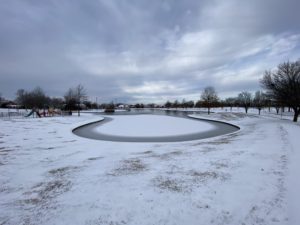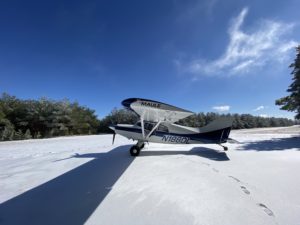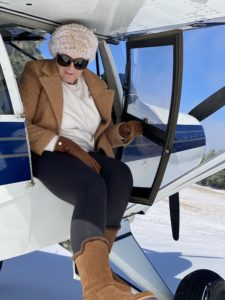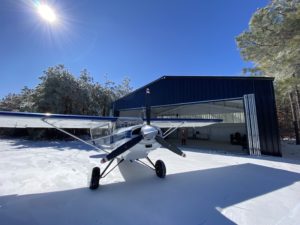What Just Happened!?
Well, the time has come. I’ve dreaded this moment for some reason. It’s not hard to tell what happened, as best I understand it. That’s straightforward and easy. It’s because I don’t want to relive the feeling of what we lost.
My wife and I took a 3-mile walk this morning around our frozen neighborhood in the 19° (which felt like 10°), frozen-world, winter, wonderland covered with 2-3 inches of sleet from the previous 24 hours. The silence and solitude were beautiful, as were our brief conversations and prayers. I couldn’t help but look at the hard, sleet-covered surface of the road and think, “I could have landed the Maule on surfaces like that easily, as I have several times. Hard-packed ice and snow isn’t a problem. But soft, wet, dense snow is.
Here’s What Happened
Let me tell you what happened, and then we can discuss lessons learned or what I would do differently if I got a do-over, which in this case, I don’t.
January 26, 2023, in the early morning we flew from Springdale, AR, where we live much of the time and keep our airplane hangared to Hot Springs, AR, to visit my wife’s sister, who has some health challenges. It was a pristine, clear, blue-skies day, and we made the smooth flight in a record 45 minutes due to a substantial tailwind out of the NW. The snow-covered mountains of the Ozarks and Ouachitas were breathtaking, and flying seemed surreal, which it often does.
After our visit, we filled up with fuel due to the expected weekend flying and headed north to our mountain-top strip, John Harris Field, or AR05, on the aeronautical charts. We flew lower northbound to mitigate the effects of the NW headwind. At 3500′, I slowed the plane and configured it to land to the north. The skies were clear blue, and the north/south runway looked beautiful in the snow. I noted it was 1210 PM. The winds at 2500′ on down to the 1777′ landing zone elevation were out of the NW (310° and steady at 10-15 knots, I estimated from the 3000′ winds aloft at RUE and what I was feeling from the airplane). I held my normal 60 MPH final approach speed steady until it was time to flare. Once we glided near the runway surface, past the windsock at the approach end, and between the pine trees which line the runway, there was practically no wind or drift to correct. Before entering the snow, I held it off in the flare to dissipate as much airspeed as possible.
When I let it settle into the snow, it seemed like our deceleration rate was typical for the landing phase. But it then decelerated faster than I could imagine. The tail came up very quickly, and before I knew it, it was straight up in the air, and then the momentum of the plane carried it on over in a somewhat slow tumble onto its back.
I would say from the “fairly normal deceleration” assessment until the tail was up vertical only took 2-3 seconds — unbelievably fast, even when I think about it now as I type. I didn’t get the time compression that sometimes accompanies these sudden events. It still seems like a blur. I had my hand on the throttle to add power if needed. If they happen, I’d read that soft snow-related incidents happen at very slow speeds at the end of the landing roll when not much air is going over the tail to hold it down. But nothing I read, thought, or heard about prepared me for this rapid deceleration. It was as if at 15-20 MPH, some gremlins threw chocks in front of the main wheels.
The only thoughts I had, at the time the tail was about 30° up in the air and moving rapidly, were: “I can’t make myself push the power up looking down at the ground at this slow speed, with no real threats around” and, when the prop hit the ground one second later, “This is going to be expensive.”
The next thing I know, my wife and I are hanging upside down in our seat belts. We release them and crawl out of the airplane onto the bottom of the pilot’s side wing. While she released her belt, I turned the master switch off, the ignition switch off, and the fuel selector to off. Then we walked away quickly in shock that it had happened. But we were unharmed and grateful.
The End.
To Stop or Not to Stop, That is the Question
Hundreds experiences work for you when flying in the backcountry from thousands of hours flying fighters and airliners. Then there are a few things that might work against you.
One such thing is the throttle. For many repetitions and landings, when I pulled the throttle to idle, it wasn’t going to be pushed back up. In the backcountry with lighter aircraft, sometimes you need to do so to get air over the control surfaces to control the airplane and prevent mishaps. I have made substantial progress in overcoming this big-muscle memory and demonstrated it at times. But this event happened too fast to react like that.
Secondly, you spend most of your career thinking snow is slick and the primary threat it presents is getting stopped from the momentum of heavy airplanes landing at high speeds. One never suspects it could be an agent for causing you to stop too quickly.
I will continue to mull this over and try to think of what I might have done differently and hear from fellow pilots their thoughts. An F-16 buddy called yesterday and after hearing my story said, “Yeah, but this is different. The snow got hold of you and flipped you over.” That isn’t a bad summary of what happened.
An older pilot friend with lots of experience told me, “CG (center of gravity) might have had some effect on you. When you fly airplanes like the Maule or a Cherokee Six that carry about anything you put in them and feel about the same when landing, one can get a little lax in thinking about it.” That’s possible for sure. If I had remotely anticipated anything like this, I would have extra bags or weight in the back to slow or help prevent the tail from coming up. And I might have landed with a bit of power on until it stopped in its tracks — very counterintuitive though. If I had dreamed it could be a problem, I wouldn’t have landed at all. All of this is hindsight and speculation. But you can’t help but try to problem-solve or be a better pilot, even when you’re still grieving the loss of something.
I wish I had had Don Sheldon to ask about the landing before I attempted it.
Paperwork
I would love to have lived in the heyday of the Alaska bush pilots, my father’s generation, just after WWII. If you want to get a feel for what that was like, as much as we can, read Wager With the Wind by James Greiner. When four friends flew our two Maules to Alaska in 2017, we landed on downtown Talkeetna’s legendary Don Sheldon’s grass strip. Back then, a similar accident would be addressed by friends trying to get you back in the air as soon as possible, with no reports, insurance companies, and massive paperwork to complete. It was more about adventure, courage, camaraderie, and survival together.
I told the gentleman who called from the Denver office of the NTSB, who was very kind and compassionate, “That’s quite a form. I’m seventy. I don’t know if I have enough time left to fill that out.” I’m just kidding, of course (sort of). I’m not cursing the darkness or calling the NTSB, FAA, or insurance companies bad guys. They are a part of why we have the safest general aviation flying in the world, offering as much freedom to US citizens as we have. And the insurance guy was as kind, sympathetic, and helpful as the NTSB representative.
I’m grateful for the aviation experience, and we’ll see where this interruption leads us. It has been a magnificent flight in life. Thanks for listening to my story and to you who have reached out, checking on us, and wishing us the best — most hoping we fly again. Godspeed to you on your journey, and His shalom be yours in abundance.







